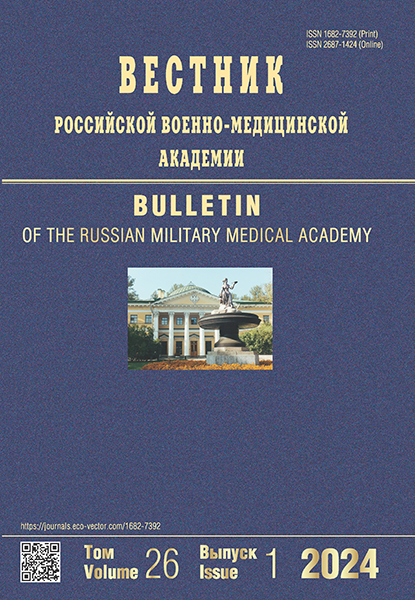A local hemostatic agent in the form of a chitosan-based gel is a promising technique for stopping ongoing intra-abdominal bleeding: an experimental study
- Authors: Golovko K.P.1, Nosov A.M.1, Yudin A.B.2, Samokhvalov I.M.1, Demchenko K.N.1, Pichugin A.A.1, Kovalevskiy A.Y.1
-
Affiliations:
- Kirov Military Medical Academy
- State Research Testing Institute Military Medicine
- Issue: Vol 26, No 1 (2024)
- Pages: 61-70
- Section: Original Study Article
- Submitted: 26.07.2023
- Accepted: 19.10.2023
- Published: 02.04.2024
- URL: https://journals.eco-vector.com/1682-7392/article/view/562796
- DOI: https://doi.org/10.17816/brmma562796
- ID: 562796
Cite item
Abstract
Bleeding is one of the most common causes of death in armed conflicts. Moreover, many medical devices have been developed to stop ongoing external bleeding, including local hemostatic agents, turnstiles, and compressors. Stopping ongoing internal bleeding remains an urgent problem in military medicine. Before the current era wherein qualified medical care is provided, internal bleeding is impossible to stop. Thus, new methods and techniques are being developed to stop (control) intracavitary bleeding at the prehospital stage. In this study, a chitosan-based agent was developed in the form of a gel to stop internal bleeding. In an experiment of large laboratory animals as models of ongoing intra-abdominal bleeding, the effectiveness of the developed drug was evaluated, and it demonstrated high hemostatic efficiency. The developed local hemostatic agent, administered by laparocentesis, could stop grade 3 bleeding according to the validated intraoperative bleeding scale from the liver wound without causing inflammatory changes in the surrounding organs and tissues. The local hemostatic agent helped avoid fatal outcomes in the experimental group compared with the control group (one fatal outcome in three animals). Changes in the hemoglobin level and erythrocyte count indicated that hemostasis occurred almost immediately after the administration of the local hemostatic agent in the experimental group, whereas in the control group, hemostasis remained unstable throughout the observation period. The histological examination of liver preparations confirmed stable hemostasis without the development of a local inflammatory reaction or necrosis when a local biocompatible hemostatic agent was used. The developed technology can be used starting from the stage of first aid, helping stop intracavitary bleeding at the prehospital stage and improving the treatment outcomes of wounded individuals and those with abdominal injuries.
Full Text
About the authors
Konstantin P. Golovko
Kirov Military Medical Academy
Email: vmeda-nio@mil.ru
ORCID iD: 0000-0002-1584-1748
SPIN-code: 2299-6153
MD, Dr. Sci. (Med.), associate professor
Russian Federation, Saint PetersburgArtem M. Nosov
Kirov Military Medical Academy
Email: vmeda-nio@mil.ru
ORCID iD: 0000-0001-9977-6543
SPIN-code: 7386-3225
MD, Cand. Sci. (Med.)
Russian Federation, Saint PetersburgAndrey B. Yudin
State Research Testing Institute Military Medicine
Email: yudin_a73@mail.ru
ORCID iD: 0000-0001-5041-7267
SPIN-code: 7060-1221
MD, Cand. Sci. (Med.)
Russian Federation, Saint PetersburgIgor M. Samokhvalov
Kirov Military Medical Academy
Email: igor-samokhvalov@mail.ru
ORCID iD: 0000-0003-1398-3467
SPIN-code: 4590-8088
MD, Dr. Sci. (Med.), professor
Russian Federation, Saint PetersburgKonstantin N. Demchenko
Kirov Military Medical Academy
Email: vmeda-nio@mil.ru
ORCID iD: 0000-0001-5437-1163
SPIN-code: 7549-2959
MD, Cand. Sci. (Med.)
Russian Federation, Saint PetersburgArtem A. Pichugin
Kirov Military Medical Academy
Email: vmeda-nio@mil.ru
ORCID iD: 0009-0001-0414-6192
SPIN-code: 9813-9694
MD, Cand. Sci. (Med.)
Russian Federation, Saint PetersburgArkady Ya. Kovalevskiy
Kirov Military Medical Academy
Author for correspondence.
Email: vmeda-nio@mil.ru
ORCID iD: 0009-0002-5525-908X
SPIN-code: 1630-7857
clinical resident
Russian Federation, Saint PetersburgReferences
- Samokhvalov IM, Goncharov AV, Chirskij VS, et al. “Potentially survivable” casualties - reserve to reduce pre-hospital lethaility in injuries and traumas. Emergency medical care. 2019;20(3):10–17. EDN: CUUXRN doi: 10.24884/2072-6716-2019-0-3-10-17
- Yareshko VG, Mikheev YA, Otarashvili KN. The concept of damage control in trauma (surgeon’s view). Medicine of urgent conditions. 2014;(7):176–180. EDN: TZCEVX (In Russ.).
- Hoencamp R, Vermetten E, Tan ECTH, et al. Systematic review of the prevalence and characteristics of battle casualties from NATO coalition forces in Iraq and Afghanistan. Injury. 2014;45(7): 1028–1034. doi: 10.1016/j.injury.2014.02.012
- Bonanno FG. Management of hemorrhagic shock: Physiology approach, timing and strategies. J Clin Med. 2022;7(2):110–113. doi: 10.3390/jcm12010260
- Rall JM, Redman TT, Ross EM, et al. Comparison of zone 3 resuscitative endovascular balloon occlusion of the aorta and the abdominal aortic and junctional tourniquet in a model of junctional hemorrhage in swine. J Surg Res. 2018;226:31–39. doi: 10.1016/j.jss.2017.12.039
- Kheirabadi BS, Terrazas IB, Miranda N, et al. Physiological consequences of abdominal aortic and junctional tourniquet (AAJT) application to control hemorrhage in a swine model. Shock. 2018;46(3S):160–166. doi: 10.1097/SHK.0000000000000651
- Duggan M, Rago A, Sharma U, et al. Self-expanding polyurethane polymer improves survival in a model of noncompressible massive abdominal hemorrhage. J Trauma Acute Care Surg. 2013;74(6): 1462–1467. doi: 10.1097/TA.0b013e31828da937
- Rago AP, Duggan MJ, Beagle J, et al. Self-expanding foam for prehospital treatment of intra-abdominal hemorrhage: 28-day survival and safety. J Trauma Acute Care Surg. 2014;77(3):127–133. doi: 10.1097/TA.0000000000000380
- Golovko KP, Samokhvalov IM, Grishin MS, et al. Use of a local hemostatic agent based on chitosan and external compression of the abdominal area to control intra-abdominal bleeding. Bulletin of the Russian Military Medical Academy. 2022;24(1):43–54. EDN: BUFMLE doi: 10.17816/brmma91155
- Cantle PM, Hurlet MJ, Swartz MD. Methods for early control of abdominal hemorrhage: an assessment of potential benefit. J Spec Oper Med: Peer Rev J SOF Med Prof. 2018;18(2):98–104. doi: 10.55460/I0EU-SQE7
Supplementary files












